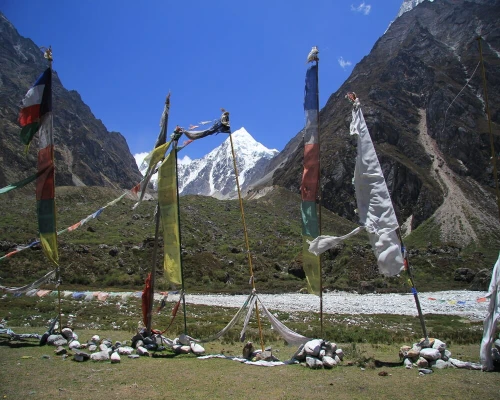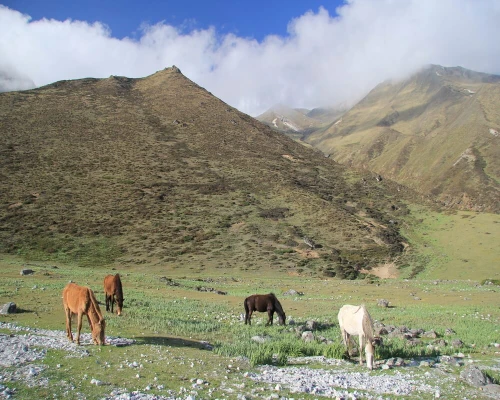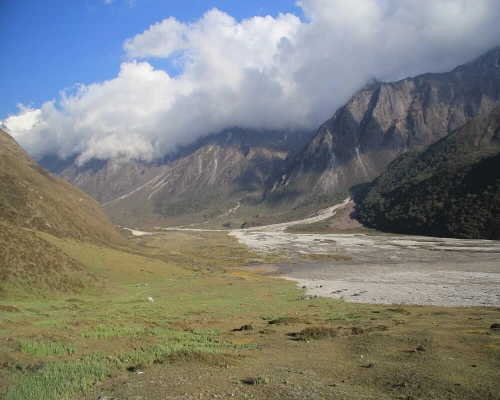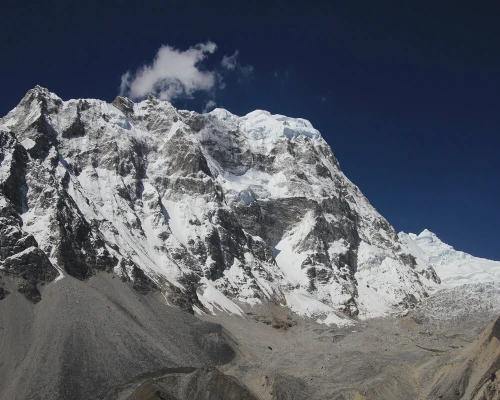The Langtang Gosaikunda Helambu Trek is a 14 day trek that takes you to an altitude of 4,380 meters. This trek is located in the Langtang region, north of the Kathmandu valley in Nepal. The region is known for its beautiful mountain glacial lakes, including the famous Gosaikunda Lake. The Langtang region is lightly populated by Sherpa and Tamang families, which gives you the opportunity to experience their unique culture and traditions. The Gosaikunda region holds great spiritual significance, with Hindu folklore believing it to be the abode of the Hindu deities Shiva and Gauri.
The trekking route in the Langtang Gosaikunda Helambu Trek is challenging yet rewarding. It takes you through diverse landscapes, including sub-alpine forests with beautiful tree species, orchids, and primroses. You will also be treated to breathtaking views of glaciers and magnificent Himalayan peaks.
One of the highlights of this trek is the chance to explore relatively isolated and less-frequented areas, allowing you to embrace the remoteness and tranquility of the surroundings. Overall, the Langtang Gosaikunda Helambu Trek offers a unique and immersive trekking experience, combining natural beauty, cultural encounters, and spiritual significance.
Amid with the fusion of the grand and far- flung gorge of the Langtang, Langtang Gosaikunda trek is truly remarkable.
- During the Langtang Valley Trek, you will have the opportunity to sightsee the amazing Langtang Gorge, a natural wonder that showcases the power and beauty of nature. The gorge is carved by the powerful Langtang River and offers stunning views of steep cliffs and rugged terrain.
- As you trek through the region, you will have the chance to immerse yourself in the local culture and get to know the Tamang and Sherpa communities. These ethnic groups have their own unique traditions, language, and way of life, and interacting with the locals will provide insights into their rich cultural heritage.
- The trek also offers the chance to relish the beauty of the peaks that surround the Langtang Valley. Mountains like Mt. Langtang Lirung (7,246m), Gang Chhenpo (6,388m), and Naya Kangri (5,846m) dominate the skyline, showcasing their majestic presence.
- One of the highlights of the trek is experiencing the fusion of diverse landscapes, cultures, and vegetation. The trail takes you through lush forests, alpine meadows, and rugged terrains, offering a unique blend of natural beauty at every step.
- Another notable feature of the Langtang Valley Trek is the opportunity to visit the renowned lakes of Gosaikunda (4,460m), Ganeshkunda, and Saraswatikunda. These sacred lakes are considered holy by Hindus and Buddhists and are surrounded by pristine beauty.
- Overall, the Langtang Valley Trek offers a remarkable journey through stunning landscapes, diverse cultures, and breathtaking mountain views, making it an unforgettable adventure for nature lovers and cultural enthusiasts alike.
Experience Langtang Gosaikunda Helambu Trek
Langtang Gosaikunda Helambu Trek can be started from Syabru Bensi or Sundarijal, located on the border of Kathmandu. Many trekkers choose to stay at Laure Binayak, which offers a breathtaking view of the Langtang Lirung (7,234m) and Ganesh Himal (7,429m) during sunrise.
During the trek, you will have the opportunity to immerse yourself in the rich cultural heritage of the region, particularly the Tamang and Sherpa communities. These communities share similarities in religion, ethnicity, language, and traditional attire with the people residing in the northern border regions. The craftsmanship, costumes, and traditionally built stone houses are a testament to centuries of existence.
The trek offers stunning views of majestic peaks such as Mt. Langtang Lirung (7,246m), Gang Chhenpo (6,388m), Naya Kangri (5,846m), and Dorje Lakpa (6,966m), which are a treat for nature enthusiasts and mountain lovers. Additionally, the trek provides opportunities to encounter diverse wildlife, including wild boars, red pandas, musk deer, Himalayan black bears, Himalayan Thars, snow leopards, rhesus monkeys, hoopoes, barbets, nightjars, laughing thrushes, and over 250 species of birds.
The Langtang Gosaikunda Helambu Trek takes you through the scenic Langtang gorge and eventually leads to the holy lake of Gosainkunda. The journey involves ascending steeply through farmland and crossing the tree line to reach the alpine crest, offering breathtaking Himalayan panoramas. There are around 108 lakes in the region, with Gosaikunda (4,460m), Ganeshkunda, and Saraswatikunda being the most renowned.
The Gosaikunda lakes hold great religious significance for both Buddhists and Hindus, who consider the water to be sacred for prayers. During the August full moon festival of Janai Purnima, many Hindus undertake a pilgrimage to bathe in the lakes.
The trek includes challenging ascents and descents through lush forests and glacial moraines, leading to Ghopte and then Chisopani before returning to Kathmandu. It offers a remarkable adventure for those with ample time and energy. You will have the opportunity to witness the unique fusion of landscapes, cultures, diverse vegetation, wildlife, and stunning mountains.
Best time of year for the Langtang Gosaikunda Trek
The best time to undertake the Langtang Gosaikunda Trek is during the autumn (September to November) and spring (February to May) seasons. During these times, the weather is generally favorable, providing optimal conditions for trekking.
In autumn, the weather is stable with clear skies, offering excellent visibility of the mountains. The temperatures are comfortable, making it enjoyable to trek through the Langtang Valley and witness the stunning landscapes. This season is popular among trekkers due to its favorable weather conditions and breathtaking views.
Spring is another great time to embark on the Langtang Gosaikunda Trek. During this season, the temperatures gradually start to warm up, and the valley comes alive with the vibrant colors of blooming rhododendron flowers. The hills and slopes are adorned with these beautiful flowers, creating a picturesque scenery that adds to the trekking experience.
On the other hand, the monsoon season (June to August) brings heavy rainfall to the Langtang Valley. The trails can become muddy and slippery, making trekking more challenging. However, if you are prepared for the rain and enjoy the solitude of the trails with fewer crowds, this season can offer a unique and adventurous experience. The fog-bound atmosphere adds a mystical touch to the surroundings, creating a different ambiance.
Before embarking on the Langtang Gosaikunda Trek, it is important to check the local weather conditions and forecasts. It is also recommended to trek with an experienced guide who can provide guidance and ensure your safety throughout the journey.
In summary, the autumn and spring seasons provide the best weather and overall conditions for the Langtang Gosaikunda Trek, allowing trekkers to fully enjoy the natural beauty of the region and have a memorable experience.
Moderately difficult trek
The Langtang Gosaikunda Trek is considered to be a moderately difficult trek. While it is accessible from Kathmandu and offers captivating natural scenery and interactions with friendly locals, it does present certain challenges.
The trek begins with a scenic drive from Kathmandu to the trailhead at Syabrubesi, eliminating the need for costly flights or overnight transfers. From there, each day of the trek takes you through charming villages, terraced fields, and lush woodlands of pine and bamboo. The journey includes a climb to an altitude of almost 5,000 meters at Kyanjin Gompa, where you can enjoy spectacular mountain views.
It's important to note that the Langtang Gosaikunda Trek involves a significant gain in altitude, which increases the risk of acute mountain sickness (AMS). To prepare for the trek, it is recommended to engage in regular cardiovascular exercise such as running or walking to improve your fitness level and endurance.
Having an experienced guide from a reputable trekking agency, such as Alpine Ramble Treks, is crucial. Your guide will have ample experience in the mountains and will ensure that you do not overexert yourself during the trek. It is important to listen to your guide's advice, hike at your own pace, and pay attention to any symptoms of AMS. Adequate acclimatization days are usually included in the itinerary to help minimize the risk of altitude-related issues. By taking necessary precautions, hiking at a suitable pace, and following your guide's instructions, you can have a safe and unforgettable adventure in Nepal's Langtang Valley.
Nepal Nomad will assist you with the coordination of the Langtang Gosaikunda Helambu Trek itinerary, accommodations, climbing permits, and flights. They will guide you throughout this thrilling and adventurous journey. If you have specific mountains or routes in mind, you can contact Nepal Nomad for personalized assistance.






